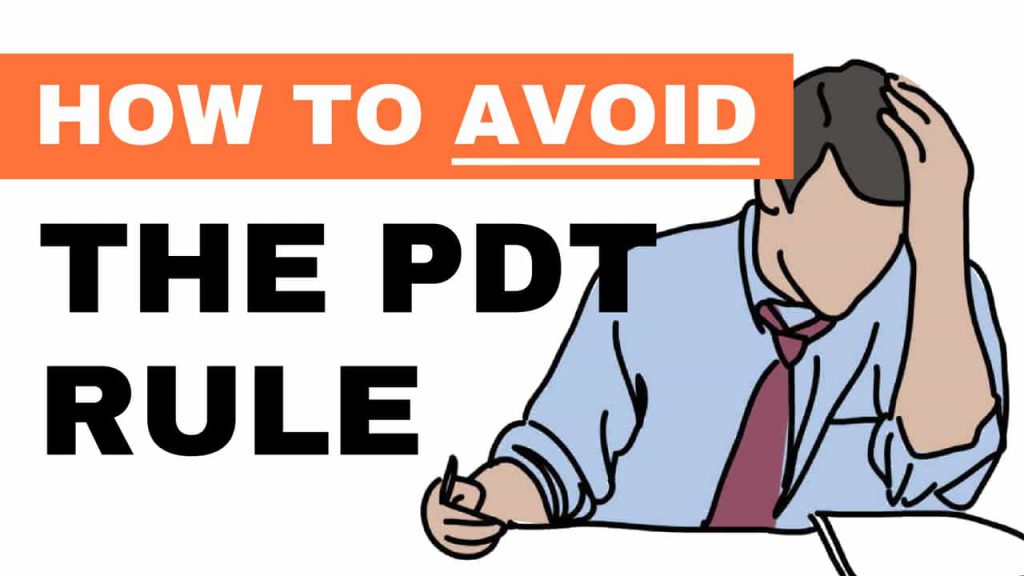Many traders seem to have difficulties understanding the PDT rule even though it is very important to understand, especially for those with smaller accounts or those that are just starting out. Thus, common questions are: ‘What is the pattern day trader rule’ or ‘how to avoid the pattern day trader rule’.
People that are under this rule often have to adjust their trading style to some degree. If you do not know what the PDT rule is, you should definitely read this article as trading without paying attention to the rule can have quite costly consequences. In this article, I will explain and break down what the rule is, why it exists, how to avoid it and more.
PDT Rule Video Lesson
Instead of reading this article, you can watch the following video lesson to learn what the PDT Rule is and how to avoid it.
What is the PDT Rule:
The Pattern Day Trader (PDT) Rule states that any margin account tagged as a ‘Pattern Day Trader’ may only trade if certain criteria are met.

The Financial Industry Regulatory Authority (FINRA) defines a ‘Pattern Day Trader’ as the following:
“The rules adopt the term “pattern day trader,” which includes any margin customer that day trades (buys then sells or sells short then buys the same security on the same day) four or more times in five business days, provided the number of day trades are more than six percent of the customer’s total trading activity for that same five-day period. Under the rules, a pattern day trader must maintain minimum equity of $25,000 on any day that the customer day trades.”
Most people probably won’t understand this definition right away as it is a very compact and complicated definition of a PDT. Therefore, I will try to break it down and simplify it.
In other words, a ‘Pattern Day Trader’ is a trader with a margin account that makes at least four full trades (open and close) in a rolling five day business period. Unless these four or more full trades are less than six percent of the client’s trading activity during this five day period. So if a customer makes 100 non-day trades during these five days, he will not be flagged as a PDT if he makes five-day trades. But this is only relevant for people with very big accounts that make tons of trades all the time.
To be allowed to day trade unrestricted while being classified as a PDT, you must have at least $25’000 in your margin account. If your balance falls below this amount, you won’t be able to day trade without limitations anymore.
What is a ‘Day Trade’:
A day trade is nothing else than a trade that is opened and closed the same day. Both a long position closed by selling and a short position closed by buying on the same day are considered a day trade. Scaling/averaging in and out of trades (opening/closing partial positions) does not count as multiple trades. So opening a 1000 share position in 3 steps does not count as a day trade. The same goes for closing, if you close a position with 3 orders, it still won’t count as a day trade. For a trade to be considered a day trade it has to be a ’round trip’ which means that both the opening and the closing transaction has to be on the same day.
What about Accounts with less than $25’000:
Most beginner traders and other people won’t trade with an account with over $25’000. If this is the case, you won’t be able to day trade like someone with such an account size. Traders with less than $25’000 are restricted to three day trades in a five rolling day period.
The PDT rule does apply to both options and stocks. It doesn’t apply to most other assets like futures, Forex etc.
Why does the PDT Rule exist:
Financial Regulators consider day trading riskier than other longer-term trading/investing strategies. The PDT rule was put in place to protect inexperienced investors from these risks by discouraging day trading. Traders with account sizes under $25’000 are considered inexperienced and thus these are restricted. A good thing about the PDT is that it prevents new beginner traders from overtrading which is a problem many traders have to deal with. In other words, the PDT rule was set in place to protect investors.
Not all traders agree with this. Actually, there are quite a few traders that dislike this rule as it limits them in their trading. There are a few ways to avoid the rule.
How to Avoid the Pattern Day Trader Rule:
- The first and most obvious way to avoid the PDT rule is by funding your account with more than $25’000. If you are able to do this, you should still be careful, as a drop below the $25’000 mark will immediately take away the ability to day trade. Ideally, you should thus deposit more. But many people won’t be able to fund their account with $25’000. Luckily there are other ways to avoid the rule.
 Another great and very easy method to avoid the PDT rule is opening a cash account instead of a margin account. The PDT rule does not apply to cash accounts. But note that other problems might come up when trying to day trade in a cash account. Besides the reduced buying power, your cash takes time to settle meaning that you can’t immediately use the money you just traded with again. Depending on the asset class that time can take longer or shorter to settle (T+1, T+2, T+3). Options are one of the assets with the lowest time until settlement.
Another great and very easy method to avoid the PDT rule is opening a cash account instead of a margin account. The PDT rule does not apply to cash accounts. But note that other problems might come up when trying to day trade in a cash account. Besides the reduced buying power, your cash takes time to settle meaning that you can’t immediately use the money you just traded with again. Depending on the asset class that time can take longer or shorter to settle (T+1, T+2, T+3). Options are one of the assets with the lowest time until settlement.
- Furthermore, there are some brokers that don’t follow the PDT rules. One typical example of a broker like that is SureTrader. These brokers aren’t regulated by FINRA/SEC and therefore they can avoid the rule. This may sound good, but brokers without good financial regulators can be sketchy. Usually, these brokers are based in countries like Cyprus, Bahamas…
- A common way of avoiding the rule is by opening multiple brokerage accounts. You have three available day trades per five day period per broker account that you open. This allows you to day trade much more. The disadvantage of this method is that you have to split your money between multiple accounts leading to a buying power reduction.
- Additionally, you could also trade a different asset class than stocks as the PDT doesn’t necessarily apply to other asset classes like Forex or futures… Before trading any new asset, it is crucial to get the correct education on it first.
- But in my opinion, one of the best ways to avoid the PDT is by holding overnight or just by holding somewhat longer. If you open a position just before the market close and close it the next day right after the market open, it won’t count as a day trade even though you only held it for a very short period. Otherwise, you could also just hold positions for a few days, weeks or even months.
- Last but not least, another way of avoiding the PDT rule is swing trading. Swing trading means holding trades for a few days, weeks or even months. Instead of staying in a position for a few minutes, you could just approach trading with a slightly longer-term approach. There is nothing wrong with staying in a trade for a few days or even longer.
Conclusion:
There are many different opinions on the Pattern Day Trader rule. Many traders despise it. But there is a reason why it exists and that is to ‘protect’ inexperienced/beginner traders.
I personally can see how people can get upset about it as it can restrict and in a few cases even harm traders. But in the end, most people that can’t afford to fund an account with over $25’000 aren’t professional/very successful traders yet. Therefore, they have to learn how to trade first. Sadly, most new traders just ignore this part and try their luck and end up losing. The PDT Rule does help in this aspect as it prevents these newbie traders from overtrading.
As you only have limited day trades when you have an account with less than $25’000 in it, I recommend saving them for the best setups only.
Depending on the strategy, you mostly won’t have to make more than three day trades per five days anyway. Remember, the PDT Rule doesn’t prevent you from making swing trades or other similar shorter-term trades.
If it really is necessary to constantly day trade, there are ways to avoid the PDT rule. But all of them do have some minor or major flaws. So you will have to sacrifice some things.
Some brokers have some broader or slightly different rules regarding the PDT. I highly encourage asking them for their rules or any modifications.
It is important to be aware of the rule if you are a shorter-term trader as it can severely limit your trading. I recommend to always track the number of day trades you made, so you don’t accidentally try to open a position before you are allowed to. Some brokers like Tastyworks, have implemented day trade counters which is a neat and handy feature. If you have used all your day trades do not open a very short-term position as you won’t be able to close it on the same day! Be very careful in this situation.

Check Out My Tastyworks Review!
I really hope this article helped you out. If you have any questions or comments, leave a comment below.


Wow that was overwhelming to read! Great job on breaking down the PDT rule. I think I get it. I don’t know much about trading, but my question would be why would someone open and close a trade in one day? From my understanding of stocks, isn’t it more of a long term investment?. Thanks.
Michael
Great question Michael.
There are countless different trading strategies. Some are longer term and some are very short term. Some traders make money by holding their stocks for a few minutes to hours so these are the traders that are affected by the PDT rule.
I heard you can get around it with a zero day contract on say SPY QQQ is this true
Thanks for clarifying the PDT rule! I currently trade on the FOREX, and have been starting to read about day trading stocks too but I soon found out that you need $25k. I wasn’t totally sure why this was, but your explanation on how to avoid the PDT rule was very helpful, i’m definitely interested in SureTrader.
I also never thought about having a few different brokerage accounts to avoid the PDT rule. Although a bit tedious, could be a good option to get going.
Thanks for the recommendation.
Glad to help!
Hi – I enjoyed reading the article above. I’m still a little confused on the rule. At the risk of sounding “sneaky”, would the following scenario count as a PDT:
$5,000 Margin Account with TD Ameritrade (for example)
Monday 10am – buy 10 shares of MSFT.
Monday 4pm – sell 8 shares of MSFT.
Tuesday 10 am – sell 2 shares of MSFT.
I’m wondering if holding part of the original trade overnight would keep the overall transaction from being considered a PDT.
I appreciate the help in understanding!
Thanks for the great question. I am pretty sure that this still would count as a day trade. As long as you open and close a trade in one asset on the same day, it will be considered a day trade. Therefore, the closing trade at 4pm would still be considered a day trade as you just opened that trade on the same day.
Hopefully, this helps.
Wow!!! great post. I really have to book mark this site. I wish I knew more about day trading as the world of stocks and trading etc really fascinates me. All the information you have provided has thrown my brain into a whirl.I think I will have to come back to your site several times before I can begin to understand even a little about trading. I really thank you for providing this information.
You’re welcome!
I found this article very interesting as I have recently began trading on the stock market. I was not awar of this Pattern Day Trader Rule. Thanks for this article it is very good and I’m pretty sure reading it I’ve got my heard wrapped around day trading now. I also found the video very informative. I’m glad I found your site, and will be checking back for sure.
You have mentioned that margin accounts wih balance above $25K can day trade. Whilst I day trade in the account should I always have to leave an amount of $25k untouched in my account or could this balance have trades which are not day trades.Basically the balance of 25k should this be the cash balance or the net liquidity position of the account
Second question what is the 6% restriction? If I have a margin account with lets say $75k of my money , Can i day trade with 50k and leave 25k untouched
Thanks …..Rizvi
Hi Rizvi,
Thanks for your question. The PDT Rule states that you must maintain a minimum equity level of $25000. So you don’t have to leave $25000 in cash, just to day trade. As long as your equity stays above that threshold, you’re good to go.
I’m not entirely sure what you are referring to with the 6% restriction. But yes, you would be able to day trade with a 75k account.
I hope this helps.
Hi,
Does pdt is apply on margin account for trading option stocks ?
Hi Mohamed,
Yes, it does.
Louis thanks for the excellent article. If I buy and sell options on the same day with settled cash, would I be in violation of the rule?
Hi George,
Thanks for the comment. No, that would be fine. But note that you can’t short options in a cash account, so you would be limited to long-only options strategies.
Another point to make is that a lot of daytraders, myself included scale an asset. 1 buy and maybe 3 or 4 sells all one 1 stock within minutes. I was checking out your info to confirm the rule for options. Thanks great information.
JD
Time to update the Article SureTrade went Bust in 2019
I heard that the real reason that the PDT rule was created was for the brokers to get larger deposits – is this true?
I don’t think so since brokers are generating most of their commissions from active traders.
I have been restricted from 2 accounts and now after 90 day restrictions have 2 violations in each account. Wish I educated myself before more before trading.
I thik someone mentioned this…….If I buy multiple shares or call options at once, I can sell these thoughout the day to prevent loss or take profit more that once in the same day. This is considered only on trade. Am I correct on this?